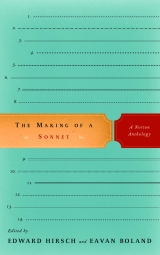
Paying attention to poetic structure, to the patterns of signficant turns in poems, is not by any means new–for a long time, thinking about poetic structure and turns has been a key feature in numerous significant discussions about poetry and types of poetry. It is in large part this fact that makes the present-day tendency toward a lack of discussion of structure so noteworthy, and so clearly in need of redress. Thus, a little book report on one of the great, earlier discussions of poetic structure: Dante’s La Vita Nuova.
La Vita Nuova is an anthology Dante created out of many of his own shorter poems. The poems are interspersed among an ongoing prose commentary that has two main features. The first is an account of the actual events which gave rise to the poems–essentially, the trajectory of Dante’s relationship with his great love, Beatrice. The second (and the feature I want to focus on here) is an analysis of the poems.
Throughout his commentary, Dante discusses how his poems work, but what’s fascinating is how he does this: Dante consistently breaks his poems down into their “parts” to reveal the structure of his poems. For example, considering his sonnet “To every captive soul and gentle lover,” Dante writes, “This sonnet is divided into two parts. In the first I extend a greeting and ask for a reply; in the second I convey what it is that requires a reply. The second part begins: Already of these hours…” Elsewhere, Dante not only divides his poems into parts but also shows how the parts themselves can be subdivided.
For Dante the awareness of the parts, the divisions, of a poem is key to understanding the meaning of that poem. At the conclusion of his analysis of his canzone “Ladies who know by insight what love is…” Dante states, “Certainly to uncover still more meaning in this canzone it would be necessary to divide it more minutely; but if anyone has not the wit to understand it with the help of the divisions already made he had best leave it alone. Indeed I am afraid that I may have conveyed its meaning to too many by dividing it even as I have done, if it should come to the ears of too many.”
But why does Dante undertake, over and over again, this particular kind of structural analysis?
In her introduction to her translation of La Vita Nuova (the Penguin Classics edition; New York: Penguin, 1969), Barbara Reynolds suggests that Dante is trying to instruct readers who are acquainted and preoccupied with the features of poetic form as to how to read his poems more vitally and accurately. Reynolds states, “What is interesting is that [Dante] evidently thinks it necessary to make clear to fellow-poets and instructed readers where the counter-divisions occur. Perhaps he considered that preoccupation with the form of poetry or with its embellishments was tending to obscure lucidity of thought.” Reynolds pursues this thinking:
“These severely arid analyses of poems…are really an invitation by Dante to enter his study and stand beside him while he runs a finger down the parchment page of his manuscript. ‘Look,’ he seems to be saying, ‘here is a canzone. You know, of course, how a canzone is constructed metrically, consisting of a sequence of identical stanzas, each stanza being composed of a frons, which is divided into two pedes, and a sirima, which is divided into two voltae. What I want you to notice is the articulation of the thought-content, for this is by no means always identical with the structural [i.e., formal] articulation…'”
That is, according to Reynolds, Dante is thinking about poems in a way that anticipates, and prefigures (by over 600 years), a similar discussion about poetry: Randall Jarrell’s “Levels and Opposites: Structure in Poetry,” one of the great essays on poetic structure, and an essay Jarrell introduces by stating, “I shall have to disregard the musical structure of poetry: metre, stanza-form, rhyme, alliteration, quantity, and so on. I neglect these without too much regret: criticism has paid them an altogether disproportionate amount of attention….I am going to talk, primarily, about other sorts of structure in lyrical poetry.” And, of course, Jarrell’s distinction between the musical structure [the form] of poetry and the other structures of poetry is a distinction that anticipated, prefigured, and inspired the structure-form distinction at the heart of the undertaking that is Structure & Surprise.
Fascinating to think, though, that issues very similar to those thought about in Structure & Surprise also were of concern to and being thought about by Dante some 700 years ago…
*
One additional note. Even though it’s clear that structure is a vital component of poetry, not everyone likes the kind of analysis; as Barbara Reynolds notes, “Some readers resent and may skip those sections of the commentary in which Dante indicates the divisions of the poems, feeling such matter-of-fact analysis to be an intrusion into the dream-world of ecstatic love which is conjured up by the consecrated tone of the rest of the work. It is said, for instance, that Dante Gabriel Rossetti, through whose translation of the Vita Nova Dante and Beatrice became part of the pre-Raphaelite movement, so disliked the paragraphs in which the poems are analysed that he could not bear to translate them and had to ask his brother, William, to undertake this part of the task for him.” Certainly, the analysis of the sections of, the turns in, a poem isn’t exactly sexy, rapturous work; however, it is, I think, a necessary part of a fuller engagement with a text, an engagement that encourages a more encompassing understanding of and feeling for how a poem moves and creates its affect. And so, it is simply necessary to keep drawing attention to this aspect of engagement with poems, especially when it seems that this aspect is being overlooked in the conversation about poetry–whenever it is that such overlooking occurs.


